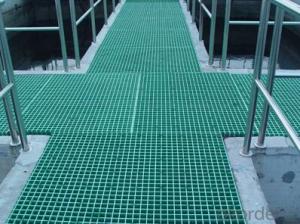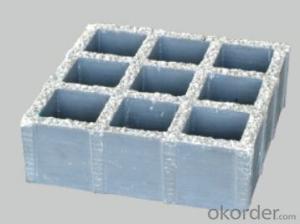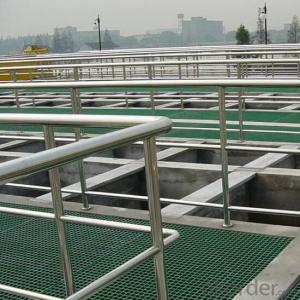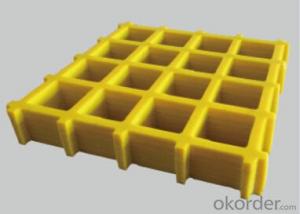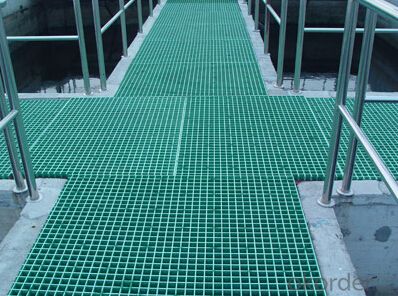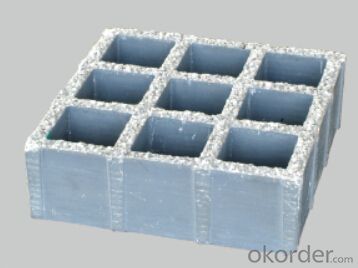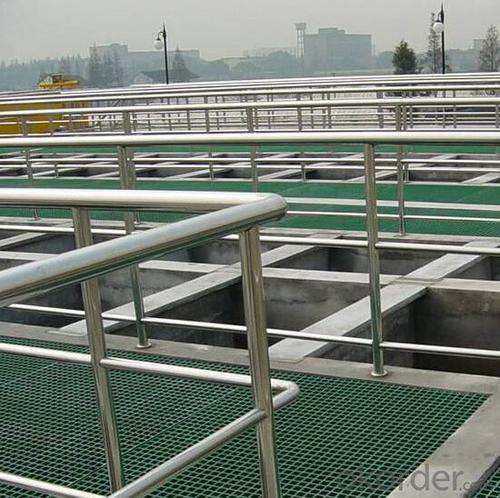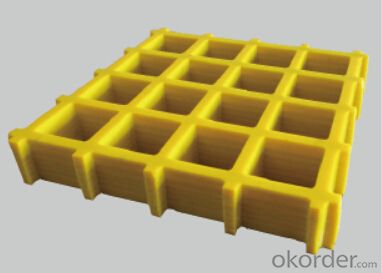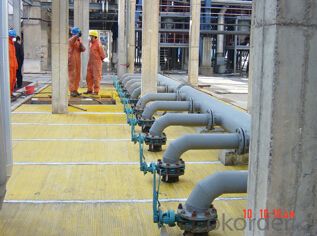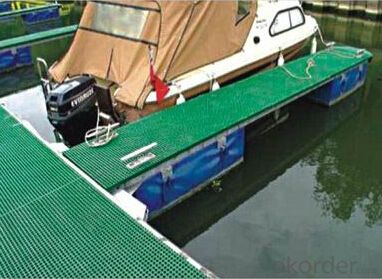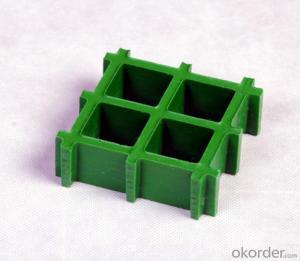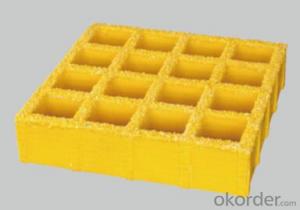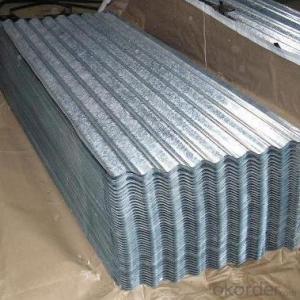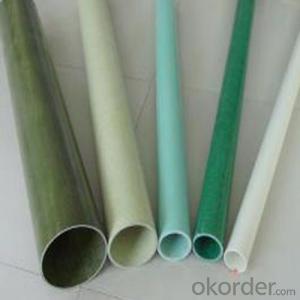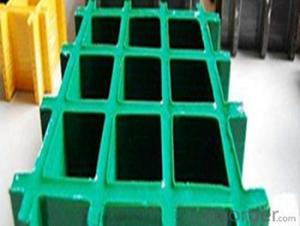FRP Pultrusion Profiles - Sewage Floor FRP Gratings with Slip Resistance
- Loading Port:
- Shanghai
- Payment Terms:
- TT OR LC
- Min Order Qty:
- 10 pc
- Supply Capability:
- 8000 pc/month
OKorder Service Pledge
OKorder Financial Service
You Might Also Like
Specification:
FRP molded grating made of vertical and horizontal continuous fiberglass fully soaked in unsaturated polyester resin giving perfect bi-directional mechanical properties. Combining unmatched corrosion resistance with strength, long life and safety, molded grating provide the ultimate in reliable performance, even in the most demanding corrosive conditions. Besides, it is easy to cut and install. CNBM offer the widest selection with panel sizes, colors and slip resistant surfaces, clients can avail FRP grating your specific requirements.
Product Features:
- Light but high loaded strength
- High anti-corrosion and anti-aging
- Easy installation and maintenance
- Low maintenance
- Non-conductive
- Lowest in life cycle cost
- Corrosion Resstance
- Anti-slippery
- Various sizes and color available
Colour Design:
To satisfy customer's design project, CNBM grating offers a wide selection of grating colors to choose from. The standard colors available for fiberglass grating as following:
- Blue
- Red
- Yellow
- Green
- Light Grey
- Dark Grey
Custom colors of fiberglass grating may be available upon request, you can contact us learn more.
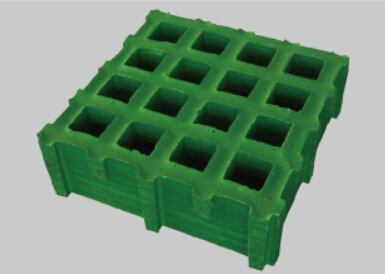
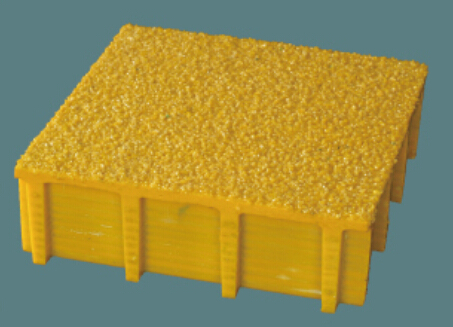

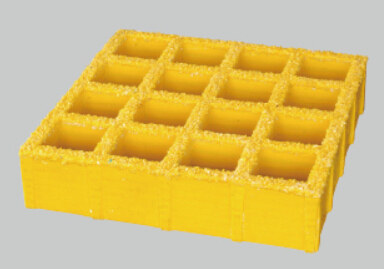
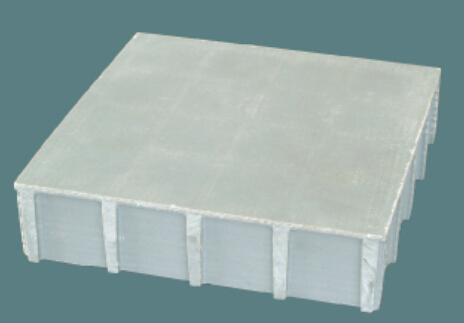
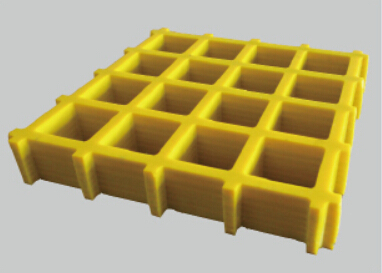
- Q: Can FRP pultrusion profiles be used in the water treatment industry?
- Yes, FRP pultrusion profiles can be used in the water treatment industry. FRP (Fiber Reinforced Polymer) pultrusion profiles are known for their excellent corrosion resistance, high strength, and durability. These properties make them suitable for various applications in the water treatment industry. FRP pultrusion profiles can be used in the construction of water treatment tanks, pipes, and other infrastructure. They are resistant to chemicals, including the harsh chemicals often used in water treatment processes. This corrosion resistance ensures a longer lifespan for the equipment and reduces maintenance costs. Additionally, FRP pultrusion profiles have a high strength-to-weight ratio, making them ideal for applications that require lightweight yet strong materials. This allows for easier installation and transportation of water treatment equipment. Furthermore, FRP pultrusion profiles offer design flexibility. They can be manufactured in various shapes and sizes to meet specific project requirements. This allows for customization and optimization of water treatment systems, ensuring efficient and effective water treatment processes. Overall, FRP pultrusion profiles are a reliable and cost-effective choice for the water treatment industry. They provide excellent corrosion resistance, high strength, and design flexibility, making them suitable for various applications in water treatment systems.
- Q: Can FRP pultrusion profiles be used in the construction of wastewater treatment tanks?
- Indeed, wastewater treatment tanks can effectively utilize FRP pultrusion profiles. These profiles are renowned for their exceptional strength-to-weight ratio, resistance to corrosion, and longevity, making them an optimal option for harsh environments such as wastewater treatment facilities. To manufacture FRP pultrusion profiles, continuous fibers like glass or carbon are drawn through a resin bath and subsequently through a heated die to attain the desired shape. This process yields profiles with consistent cross-sections and outstanding mechanical properties. In the construction of wastewater treatment tanks, FRP pultrusion profiles can serve various purposes. They can function as structural components, like beams, columns, and bracing systems, offering the necessary strength and rigidity to support the tank structure. Additionally, FRP profiles can reinforce concrete structures, bolstering their durability and resistance against chemical attack from the wastewater. Moreover, FRP pultrusion profiles can be engineered to endure the corrosive impact of the chemicals and gases found in wastewater treatment tanks. Unlike conventional materials such as steel or concrete, FRP exhibits a high resistance to corrosion, guaranteeing an extended service life and reduced maintenance expenses. Furthermore, FRP profiles provide advantages in terms of installation and transportation. They are lightweight, enabling easier handling and diminished labor requirements during construction. The modular nature of FRP profiles also facilitates swift assembly and disassembly, simplifying maintenance and modifications. Overall, incorporating FRP pultrusion profiles in the construction of wastewater treatment tanks offers numerous benefits, including superior strength, corrosion resistance, durability, and ease of installation. These advantages render FRP a dependable and cost-effective choice for wastewater treatment facilities.
- Q: Are FRP pultrusion profiles resistant to oils and greases?
- Yes, FRP pultrusion profiles are generally resistant to oils and greases. The combination of fiberglass reinforcement and resin matrix in FRP pultrusions provides excellent resistance to various chemicals, including oils and greases. This makes them suitable for applications where exposure to oils and greases is expected.
- Q: Are FRP pultrusion profiles suitable for the manufacturing of antenna masts?
- Yes, FRP pultrusion profiles are suitable for the manufacturing of antenna masts. FRP pultrusion profiles offer several advantages such as high strength-to-weight ratio, corrosion resistance, and excellent electrical insulation properties. These characteristics make them ideal for antenna mast construction, as they can withstand various environmental conditions and provide reliable support for antennas.
- Q: Can FRP pultrusion profiles be used in railway applications?
- Yes, FRP pultrusion profiles can be used in railway applications. They are lightweight, corrosion-resistant, and have high strength-to-weight ratio, making them suitable for various structural and non-structural components in railway systems such as platforms, walkways, handrails, and cable management systems. Additionally, FRP profiles offer excellent electrical insulation properties and can withstand extreme weather conditions, making them a reliable choice for railway applications.
- Q: Are FRP pultrusion profiles fire resistant?
- FRP pultrusion profiles exhibit excellent fire resistance due to the combination of reinforcing fibers and the polymer matrix employed in their production. These profiles are crafted through the pultrusion process, wherein reinforcing fibers like fiberglass or carbon fiber are impregnated with a thermosetting resin. This resin undergoes a curing process, resulting in a robust and durable composite material. One of the primary advantages of FRP pultrusion profiles lies in their inherent fire resistance. The thermosetting resin utilized in their manufacture possesses properties that render it highly impervious to fire. When subjected to flames or elevated temperatures, the resin does not easily burn or melt, thereby impeding the propagation of fire. Moreover, the reinforcing fibers present in FRP profiles contribute significantly to their fire resistance. For example, fiberglass, being an inorganic substance, does not combust. It serves as a heat transfer barrier, aiding in the containment of flames. Additionally, FRP pultrusion profiles can be engineered to meet specific fire safety standards and regulations. By incorporating supplementary fire retardant additives or employing specialized resin systems, the fire resistance of these profiles can be further enhanced. It is crucial to note that although FRP pultrusion profiles do possess fire resistance, their precise fire rating may vary depending on the particular composition and design. Thus, it is imperative to consult manufacturers or suppliers who can furnish comprehensive information regarding the fire resistance properties of their FRP pultrusion profiles.
- Q: Can FRP pultrusion profiles be used in pedestrian bridges?
- Yes, FRP pultrusion profiles can be used in pedestrian bridges. FRP (Fiber Reinforced Polymer) pultrusion profiles offer several advantages such as high strength-to-weight ratio, corrosion resistance, and durability, making them suitable for pedestrian bridge applications. These profiles can be customized to meet specific design requirements, ensuring the safe and efficient construction of pedestrian bridges.
- Q: Are FRP pultrusion profiles resistant to impact and vibration?
- Yes, FRP (Fiber Reinforced Polymer) pultrusion profiles are generally highly resistant to impact and vibration. The combination of resins and fibers used in FRP pultrusion manufacturing makes the profiles inherently strong and durable. The fibers, typically glass or carbon, provide high tensile strength, while the resin matrix offers additional toughness and resistance to impact. Due to their unique composition, FRP pultrusion profiles have excellent energy absorption properties, which allows them to withstand impacts without significant deformation or damage. This makes them suitable for applications where impact resistance is crucial, such as in construction, transportation, and infrastructure projects. Moreover, FRP pultrusion profiles exhibit remarkable resistance to vibration. The composite material's inherent damping characteristics help dissipate and dampen vibrations, reducing the risk of structural fatigue and increasing the longevity of the profiles. This vibration resistance makes FRP pultrusion profiles ideal for use in environments with high vibration levels, including industrial machinery, bridges, and marine structures. However, it is important to note that the specific impact and vibration resistance of FRP pultrusion profiles can vary depending on factors such as the type of resin used, the reinforcement fibers employed, and the design of the profile itself. Therefore, it is advisable to consult with the manufacturer or supplier to ensure that the chosen FRP pultrusion profiles meet the specific impact and vibration resistance requirements of the intended application.
- Q: Plastic or better glass fiber reinforced plastic better?
- Glass fiber reinforced plastics, usually glass fiber reinforced unsaturated polyester, epoxy resin and phenolic resin matrix. Because of the different kinds of resins used, they are called polyester glass fiber reinforced plastics, epoxy glass fiber reinforced plastics and phenolic resin glass fiber reinforced plastics. Its characteristics are: light and hard, non conductive, stable performance, high mechanical strength, less recycling and corrosion resistance. It can be used instead of steel to make machine parts, automobiles, ship shells, etc..
- Q: Can FRP pultrusion profiles be used in the construction of conveyor systems?
- Yes, FRP (Fiber Reinforced Polymer) pultrusion profiles can be effectively used in the construction of conveyor systems. FRP pultrusion profiles offer several advantages that make them suitable for such applications. Firstly, FRP pultrusion profiles are lightweight yet strong, making them ideal for conveyor system construction. Their high strength-to-weight ratio allows for easy installation and maintenance, reducing the overall weight of the system while maintaining structural integrity. This feature is particularly beneficial when designing and building long-span conveyor systems. Secondly, FRP pultrusion profiles are highly corrosion-resistant. Unlike traditional materials like steel or aluminum, FRP pultrusions are resistant to rust, chemicals, and moisture. This resistance makes them suitable for conveyor systems that may be exposed to harsh environments or corrosive substances, such as in mining or chemical industries. Another advantage of FRP pultrusion profiles is their electrical insulation properties. They do not conduct electricity, which is a crucial requirement in conveyor systems where electrical components are present. This property ensures a higher level of safety and reduces the risk of electrical hazards. Furthermore, FRP pultrusion profiles can be easily customized to meet specific design requirements. They can be manufactured in various shapes and sizes, allowing for flexibility in conveyor system design. Additionally, FRP profiles can incorporate features such as channels, slots, or reinforcements, which can be advantageous for mounting accessories or facilitating the movement of goods on the conveyor. Lastly, FRP pultrusion profiles are durable and have a long service life. They are resistant to UV degradation and do not require frequent maintenance or painting, reducing lifecycle costs compared to traditional materials. This durability makes them a cost-effective choice for conveyor system construction. In conclusion, FRP pultrusion profiles are an excellent choice for the construction of conveyor systems. Their lightweight, corrosion resistance, electrical insulation properties, customization options, and durability make them a reliable and efficient material for such applications.
Send your message to us
FRP Pultrusion Profiles - Sewage Floor FRP Gratings with Slip Resistance
- Loading Port:
- Shanghai
- Payment Terms:
- TT OR LC
- Min Order Qty:
- 10 pc
- Supply Capability:
- 8000 pc/month
OKorder Service Pledge
OKorder Financial Service
Similar products
Hot products
Hot Searches
Related keywords
